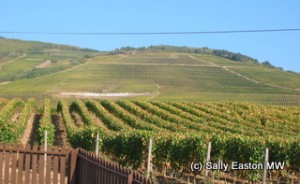Lord of the sweets
In Tolkien’s Middle Earth are made some of the most enticing and ethereal sweet wines. Or so it seems in middle Europe’s north-east corner of Hungary, close to the Slovakian and Ukrainian borders. The confluence of the rivers Bodrog and Tisza, sounding just like another challenging situation for the battle-weary Frodo and Sam, contains the long- and illustrious-historied region of Tokaj, oft-forgotten vineyards of one of the most ancient of all the demarcated vineyard areas.

Hétszőlő Vineyards
Sandwiched between the volcanic Zemplén Hills to the north and the great Hungarian plain to the south, just 5,500 ha of white-only grape varieties exist on the south and south-east facing foothills, overlooking those two rivers on which they depend. It is in the mists of both time and these rivers that the mythologies of Tokaji wine are born. The rivers still engender the daily mist to bring noble rot to the autumnal vines.
But, it is only since 1989 the region has been clawing its way out of nearly fifty years of Communist rule, out of the shadow of Mordor. Early foreign investment gave a much-needed injection of capital and technological expertise to begin re-discovering the true Tokaji, work that is still the subject of debate. Should the style focus on nuttiness and baked fruit, or fresh fruit with a savoury hint of botrytis? What remains true is that Tokaji has, despite its sweetness, a rapier-like freshness of acidity that leaves the palate fresh.
Tokaji has one of the most complex production methods imaginable. That it results in liquids of luscious limpidity, liveliness, length and, frankly, loveliness means the efforts are worthwhile. It is easy to forget how simply delicious these sweet wines are. In essence, healthy bunches of grapes are harvested to make dry wine. A botrytis (as in Sauternes, beerenauslese, trockenbeerenauslese, Ruster Ausbruch etc) sheen in the vineyard is combined with a shrivelling of the grapes – berry concentration by wind in this regularly breezy patch of land.
Botrytis and shrivelled grapes are hand picked individually (aszú berries), often in a number of passages through the vineyard, as in Sauternes. These are kept safe until there’s enough. Berries are added to the dry wine (or sometimes unfermented grape juice) in measured units of 3, 4, 5, or 6 puttonyos. Anything more than 6 puttonyos and it’s called aszú-eszencia. Wine and berries are macerated for 1-3 days to extract all the goodies in the berries (flavour, acidity, sugars, aromas).

Picking aszú berries
The number of puttonyos added determines the sweetness of the final wine. The berry/wine liquid is pressed and a bit of fermentation takes place in the now sweet wine. It must age for at least two years, and does so in underground labyrinthine tunnels, reminiscent of Shelob’s lair. Thick cobwebs adorn the winding, deepening, stooping, chilling tunnels, lined with barrel upon barrel of serenely maturing Tokaji wine. But for Hobbits and humans there is nothing more sinister than a velvet-soft fleece of mould clinging to the tunnel walls and ceiling, which feeds on the alcohol evaporating from the maturing wine.
Is Tokaji nectar of the gods perhaps, or miruvor of the elves, that precious, fragrant liquor which conferred new strength of heart, gave fresh hope and vigour to Fellowship of the Ring as it was defeated by the snowstorm on mount Caradhras and forced to go down into the mines of Moria. It is certainly a restorative potion, and one that opens up gastronomic opportunities.
Tokaji comes in a variety of easy to identify sweetnesses:
3 puttonyos > 60 g/l residual sugar
4 puttonyos > 90 g/l residual sugar
5 puttonyos > 120 g/l residual sugar
6 puttonyos > 150 g/l residual sugar
Aszú-eszencia > 180 g/l residual sugar
By the time the wine has finished maturing, alcohol can be as low as 9% (maybe 6% for aszú-eszencia) but it’s more usually around 12%, really quite modest by today’s standards. This is noticeably lighter than Sauternes, for example, and there is rarely new oak influence in Tokaji, so food matching is much simplified. Indeed the secret of Tokaji is the balance between sugar and acidity which results in an elegant, fruit-concentrated potion, with complex flavours of citrus fruits, apricot, peach, tropical fruits, cinnamon, nuts, chocolate, fresh-roasted coffee.
As with Sauternes, the foie gras connection is obvious, but the range of Tokaji makes it a more adaptable food pairing wine. Lighter sweetness with piquant ham starters, sweeter styles with rich blue cheeses such as Roquefort or England’s Barkham Blue, and with seriously mature cheddar or other flavoursome hard cheese. High acidity fruit desserts or sorbets of apricot, pear, raspberry, strawberry, kiwi, mango or pineapple are well suited to the zingy freshness of Tokaji’s acidity. Tokaji sorbet perhaps?
Spare even a thought for Christmas pudding with its crystallised fruits and nutty notes, and spiciness form cinnamon, nutmeg and allspice, all complementing the spicy notes of the wine.
Chef Tibor Hornyák at the Gróf Degenfeld Palace restaurant in Tokaj recommends roasted duck liver with onion ragout flavoured with almond and dried apricot, or broccoli souffle with gorgonzola sauce, with an aszú 3 puttonyos; a cappucino-mousse with amaretto sauce with aszú 4 puttonyos; gingerbread parfait with caramelised fig, or strawberry cottage-cheese mousse with aszú five puttonyos; and a Gundel pancake for the aszú 6 puttonyos, whose chocolate sauce and walnuts complements the sweetest wines.
Of the Aszu Eszencia, the folk at Disznókő seem to have the right idea: “We advise drinking it in small portions, by itself, to celebrate life.” Frodo would probably agree.



